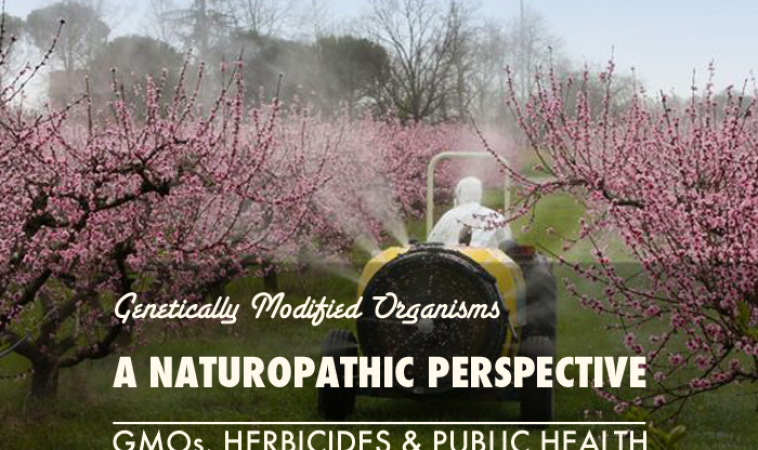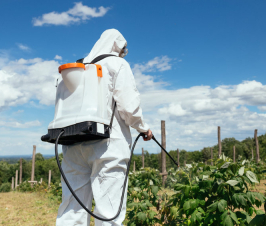The New England Journal of Medicine just published an article entitled GMOs, Herbicides and Public Health that called for the Food and Drug Administration to require mandatory labeling of GMO foods. The article discusses the use toxic herbicides, their link to adverse health events such as cancer, and the possible danger of new herbicides being approved by the EPA. NaturalPath expert Bianca Garilli, ND shares her personal experiences as a summer worker on a farm, and a naturopathic perspective on this crucial topic.
Dr. Bianca Garilli, ND
@DoctorBianca
Knowledge is not static. A classic case in point: today the earth is known to be round, but that has not always been the general belief. Time changes our understanding of how things work, their implications and their impacts. The topic of GMOs and Enlist Duo are no different. There is new information that needs to be considered, which is discussed in this August 20, 2015 NEJM article. Because these food topics have an impact on human health and environmental outcomes, they should be studied with extreme care based on unbiased research that strives to bring to light all potential pros and cons.
I may have been one of the first waves of summertime Iowa high school students to have used the new and improved version of Roundup. I remember the farmers talking excitedly to our group of local summer workers telling us that we no longer had to worry about spraying ONLY the soybeans but that it was fine to spray everything now! This was the early 1990s and all we cared about was getting finished so we could go and spend our hard earned bucks “in-town”. For several weeks each summer, my friends and I would sit on fold-out chairs that were attached to the front of the tractor, allowing each of us to be aligned directly over a row of crops as the tractor slowly moved its way up and down the 100s of acres that needed to be sprayed. We were each given our very own spray gun with which to attack the plants. These spray guns were attached to hoses which were fed from a large tank of – wait for it – Roundup!
After 5-6 hours baking in the Iowa sun, my “work day” was done, and I was free again until 6 am the next morning. At the end of each afternoon we were all a big, sticky mess with spray residue coating our entire bodies, after all, it was hot so we wore shorts and tank tops. The wind was typically blowing while we sat on those tractor seats whipping the Roundup right back into our faces so that we were essentially wearing it, breathing it and eating it. We did not wear protective gear – no masks, no eyewear. We were just high school kids with a summer job.
Looking back with nostalgia on my “farm days,” I often wonder today what exposures I incurred – did that have any effect on my long term struggle with chronic fatigue or did it in any way contribute to the health of my future child who would, over a decade later, be born with a congenital heart defect? There’s no way to tell. And, that’s the just one piece to this cautionary tale discussed in this very-well researched and written article. Do we need further consideration of all aspects of the safety of plant biotechnology? Yes. Do we need to revisit our country’s GMO food labeling laws? Yes.
If we don’t heed this very logical and completely rational call to action urged by Doctors Landrigan and Benbrook, then we may never truly know the implications of such a dramatic shift in the growing and production of a very vital source of life – our food.
Has the increase in the GMO crop production and insertion into nearly all commercially processed foods have anything to do with the CDC’s statistics showing that among children aged 0–17 years, the prevalence of food allergies increased from 3.4% in 1997–1999 to 5.1% in 2009–2011? Has it had an impact on the prevalence of skin allergies which increased from 7.4% in 1997–1999 to 12.5% in 2009–2011? I bet these children and their families would like to know. And, if we were to find that indeed, there are negative health implications from these methods of food production, wouldn’t it be nice to allow these families to have the option to know which foods and which methods of production were the culprits so they could remove them from their family’s diet?
I don’t know what the answers are. What I do know is that people deserve to have information from which to make choices and sometimes a swift decision from “those in charge” without all necessary data can lead to profoundly devastating effects on large groups. I believe we need to take more time to study the impact on health in all organisms before placing Enlist Duo into our food system and that consumers have the right to know what they are eating.
I will always weight my vote on the side of caution. Check, double check, then check again. Before riding our galloping horse through the dark, black night on an unknown road with twists and turns, let’s light a lantern, grab a map and be sure we know where we are going.
 Dr. Garilli is a former US Marine turned Naturopathic Doctor. She runs a private practice in Folsom, California where she specializes in treating and preventing chronic disease states through a personalized lifestyle approach including nutrition, exercise, botanical medicine and homeopathy.
Dr. Garilli is a former US Marine turned Naturopathic Doctor. She runs a private practice in Folsom, California where she specializes in treating and preventing chronic disease states through a personalized lifestyle approach including nutrition, exercise, botanical medicine and homeopathy.
In addition to private practice, she consults with nutritional supplement companies and integrative medical clinics on case studies, professional consultations and educational program development. Dr. Garilli is a member of the faculty at Hawthorn University and a founding board member for the CA Chapter of the Children’s Heart Foundation. Dr. Garilli lives in Northern California with her husband, children and four backyard chickens.
Reference:
Landrigan, PJ, Benbrook, C. GMOs, Herbicides, and Public Health — NEJM. New England Journal of Medicine. Available at: http://www.nejm.org/doi/full/10.1056/nejmp1505660. Accessed August 24, 2015.

















